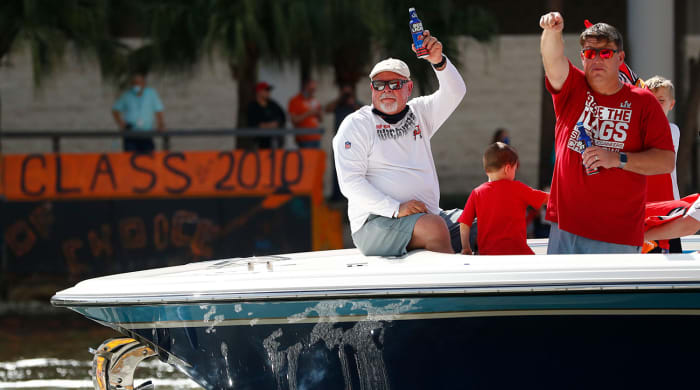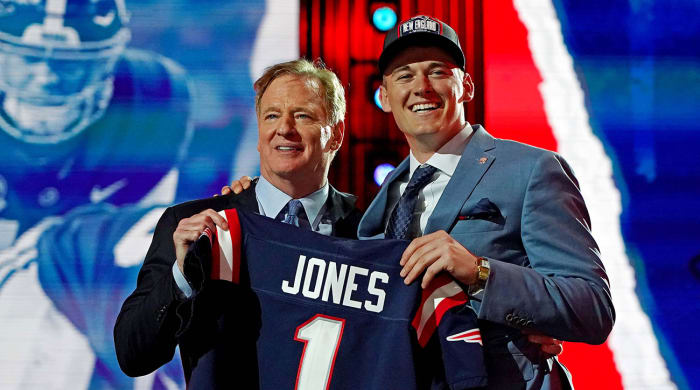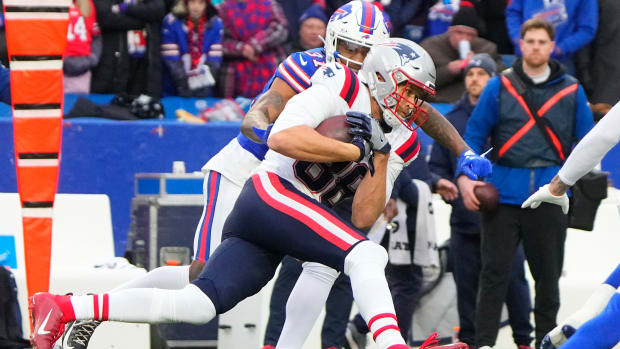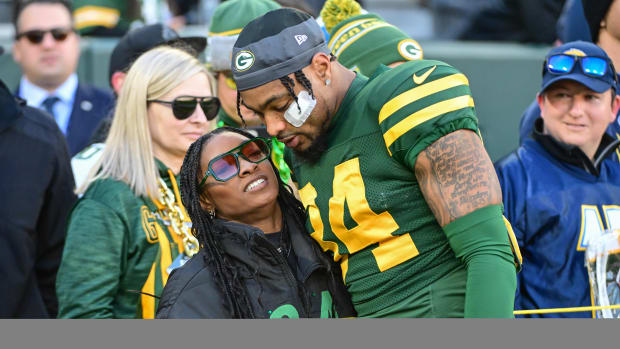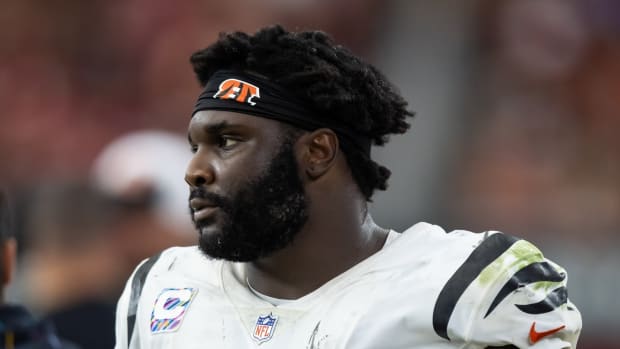GamePlan: Ron Rivera Discusses Changes Ahead of Year 2 in Washington
His first season was over, and thus commenced the second phase of Ron Rivera’s overhaul of Washington’s football operations. That meant completely reshaping the scouting department to align with the head coach and his staff, which started with finding the right general manager.
Rivera had a couple of easy connections he could pull on. One was to his GM in Carolina, Marty Hurney, with the Panthers and their long-time executive’s having parted ways. Another was to ex–Lions GM Martin Mayhew, who shares an agent with Rivera and is a longtime friend.
Both interviewed. Afterward the coach, torn, huddled with owner Dan Snyder.
“Do you like them both?” Snyder asked.
“I like them both a lot,” Rivera responded.
Snyder then looked at Rivera and asked, “Would you like to have them both?”
“Yeah, I’d love to have both,” Rivera said, “if we could swing that.”
It took some finagling with titles—Mayhew was named GM, Hurney EVP of football/player personnel—but that wasn’t what was relevant to Rivera. What was?
“It was about getting as many good people as possible,” Rivera said on Wednesday.
And he didn’t have to guess about what he’d be getting with either guy.
The crux of all this, for Rivera, is to keep the Washington Football Team moving forward, and not looking back to where it was when he got there. It was as big a rebuild as you’ll find in the NFL then, and that was before chaos truly ensued—with the name change, with Washington Post reports detailing a toxic workplace environment and with Rivera’s own battle with squamous cell carcinoma, a form of cancer that Rivera’s docs found in August.
Through all that, Rivera and his staff won the NFC East, took the eventual world champion Buccaneers into deep water before bowing out in the wild-card round and changed the mentality of the locker room along the way.
And after all of it, he saw Hurney and Mayhew as the two best qualified to make sure there’d be no turning back. Four months after landing both, Rivera feels even better that he doesn’t have to worry about that anymore.
We’re into the quieter time on the NFL calendar, but there’s still a lot to get to in this week’s GamePlan. Inside the column, you’ll find …
• My post-draft power rankings!
• When we can expect to see the rookie QBs take the field.
• How many players are actually showing up for offseason programs.
But we’re starting with Rivera and the Football Team, and where it’s going next after taking a significant step forward in 2020.
Now, there are reasons why front offices usually aren’t set up the way that Washington has set up its new one. One would be that it’s hard to bring in two guys with the résumés that Hurney and Mayhew have in one fell swoop. Another is that in the ultra-competitive NFL, where coaches and scouts routinely step over one another to get ahead, the idea of having not one but two executives atop the scouting org chart is easier to discuss than implement.
But so far, so good.
As Rivera sees it, who Hurney and Mayhew are as people is key to making it work. After that, it really goes to how each guy is deployed, and how one’s strengths complement the other’s, and vice versa.
“The biggest thing, Marty’s a little bit more get-my-hands-dirty out there in the scouting world, and going out on trips and being out of the office for a week or two at a time, where Martin is a little more in the office, on the tape, handling the day-to-day stuff, the communication between us and the league,” Rivera said. “That’s where you see the difference; Marty does a little more of the road work that you have to do in pooling all the information you get on the player, where you see Martin do it a little differently.”
And the perfect example, from Rivera’s perspective, is how the team reworked its offensive line from all angles. Indeed, Hurney was the one on the ground in Austin for Texas OT Sam Cosmi’s dynamite pro day workout, while Mayhew was in the office sifting through veteran options—eventually landing on a predraft trade to bring ex-Washington guard Ereck Flowers back to D.C. from Miami, with the cost standing as just an exchange of late picks.
Therein, Washington landed, potentially, its starting left tackle and starting left guard.
Then, during the draft, Rivera was looking to bolster the special teams with Michigan snapper Camaron Cheeseman. Hurney made the connection with the division rival Eagles on the idea of trading next year’s fifth-rounder for Philly’s sixth-rounder (225th), and Mayhew worked on valuing the trade, imploring that Washington should push for another pick as part of the deal. The Eagles, in the end, wound up throwing in its their seven (240th).
“Those guys have done a great job communicating and working together. I really appreciate the way they’ve worked with me,” Rivera continued. “Individually, we have great relationships. I’ve known both guys for a long time. So that’s one thing that gives me a lot of confidence in who they are. Secondly, as a group, collectively, we work really well together. It’s really not about me. It’s about gathering information, getting the best information and, at the end of the day, going really with what we’ve talked about as a group.
“And quite honestly if one of us has a different opinion, we all listen.”
And that’s led to a pretty disciplined approach over the last four months.
Finding the right kind of guy was going to be important. This connects back to Rivera’s strong desire not to take any steps back after all the progress of last year. So character counted with big-ticket free agents like Curtis Samuel (who played for Rivera in Carolina), Adam Humphries and William Jackson, and it mattered with the draft picks too—with all those guys having really done well in the interview setting with the WFT staff.
“One of the first things we talked about is character,” Rivera said. “Does his character fit our organization, our culture? Is this the kind of guy that we want in the culture? And we all talked about it, we all discussed it. And then, what are their skill sets, what are they capable of? In most cases, these are guys that we felt like we took at the right spot.”
And with the draft picks, the character was an added layer to the bigger picture.
If there was another tie that bound the draft class, it was untapped upside. First-round pick Jamin Davis, a freakish athlete, was only a one-year linebacker for Kentucky. Sam Cosmi posted explosive testing numbers at that pro day, but there were questions coming out of Texas on how well he was coached—and the WFT staff is going to work on hand usage and placement to help clean up technique issues. Benjamin St-Juste is a long, rangy corner who could take off in the right scheme. Dyami Brown’s a burner who’s battled what Rivera calls “concentration drops” (“He reminds us a lot of Terry McLaurin,” Rivera said).
In each case, the player’s character informed Rivera, Mayhew and Hurney that the player was going to keep working at it—which would give the player and team the best chance to tap into the upside there, while also fitting into the locker room.
“Our first two days,” said Rivera of those four, “we were very pleased. We really were.”
They weren’t going to overreach for a quarterback. One thing I’d heard on Washington going back a couple months was they were content, after signing Ryan Fitzpatrick, and with Taylor Heinicke and Kyle Allen back, to keep building the team up and treading water at quarterback, if that was the way the dominoes fell. There were two reasons why. One, it’d give the team a chance to create a better situation to, eventually, drop a young quarterback into. And two, it’d allow Washington to keep filling holes.
“That was probably the biggest part of the conversation—if we do this and this and this, then we’ve gotta give up this draft capital and that draft capital, and then we’re still looking to fill these needs,” Rivera said. “That was always a part of the conversation, what we were going to do and how it would take away from our opportunity to fill those needs. Some of the early conversations we had on what people were looking for, what they wanted, we just didn’t want to give that up.
“The other thing too, this is the other thing to think about now, go back and look at who’s won the Super Bowl the last several years. How many of those guys are repeat quarterbacks other than Tom Brady. I mean, you see Nick Foles won a Super Bowl. Good for Nick, that’s outstanding. But let’s understand they had a good football team around him. If you have a good football team around the quarterback, what’s to say you have to have Brady? Now, it’d be great to have a Brady–type guy. But if it’s not out there, why are we gonna force it?”
Now, even after all those conversations, Rivera said there was a quarterback or two in the class that Washington did feel strongly about. And that even carried into draft day.
“Oh yeah, we did,” Rivera said. “At one point, we started saying, ‘Wait a minute, this happened, guys, let’s take a look at this and start talking. If this guy’s at that point, would we go up and do something?’ We had that conversation, and we stayed with that conversation for quite some time.”
My educated guess would be that what they were looking for was always going to cost a future first-rounder, and they weren’t willing to do that. Obviously it’s moot now.
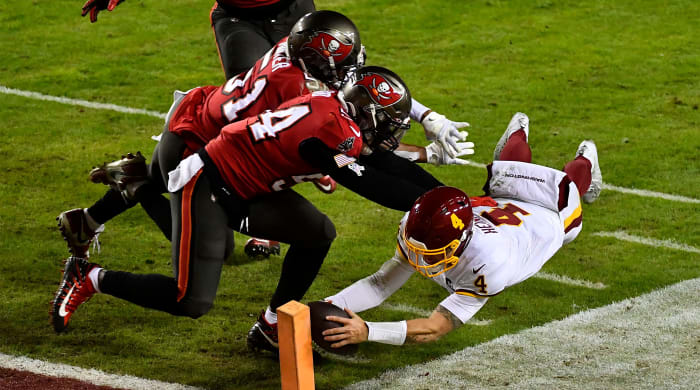
Taylor Heinicke diving for the pylon in Washington's spirited playoff effort.
Brad Mills/USA TODAY Sports
Rivera was quick to emphasize, too, that Washington can keep moving forward because of how much was accomplished by the players last year, which brings us back to the change in mentality the coaches were looking for and wound up getting.
“Really, the biggest thing we tried to do was get past the, Oh, here we go again moments,” Rivera said. “You’re winning, you’re up 24–7, you turn the ball over, the other team goes right down and scores right away. And then you’re about to go three-and-out, and you punt, they’re about to get great field position and everybody goes, Oh no, here we go again. F---, we’re gonna get our asses beat again. And you’re up by 10 points!
“The score’s 24–14 and you’re sitting there thinking about hanging on and not losing, instead of going out and kicking their ass.”
The change, as Rivera saw it, came in a four-game winning streak that straddled November and December. In each of those wins over the Bengals, Cowboys, Steelers and 49ers, the coaches saw a tipping point, where a Chicken Little mentality could have crept in, and in each case Washington responded by choking its opponent out.
It’s why (that, and the state of the NFC East) they won the division after a 2–7 start that included the benching, then releasing, of former first-round quarterback Dwayne Haskins, and it’s why Rivera has had his eyes trained on maintaining the momentum his team built going into 2021.
The good news is it shouldn’t be nearly the lift it was last year. Rivera points out that his roster carried 28 first-, second- or third-year players who played “meaningful minutes” in big games for Washington last year—“It wasn’t like they were only playing in the fourth quarter when we were getting the s--- kicked out of us or we were winning big”—and anyone would be hopeful those players would keep ascending.
Moreover, with those guys, and the rest of the team, now having proof that what the coaches and staff were selling last year works, they can be salesmen of the culture to all the new guys coming in, which is another step toward having a program that’s self-sustaining.
“Exactly, and hopefully we don’t have to waste our time with that stuff. And that’s a valuable point to this whole thing: Guys, let’s not waste what we created last year, let’s not waste that momentum putting ourselves in that position,” Rivera said. “That’s what I’m hoping our guys get, I’m hoping our guys understand how important that all is.”
Logically, given all they went through last year, Rivera’s got reason to believe they do. And if they need reinforcement, Rivera can point to everyone who’s arrived since January.
It’s not too difficult to tie the whole thing together.
POWER RANKINGS
This week, for the site, we had to do our post-draft power rankings poll. As usual, and much to my editor Mitch Goldich’s chagrin, I waited until the last possible moment to get them in. But I just made it, after a number of reminder texts. While the poll is anonymous, here’s what I sent in.
1) Buccaneers: Bruce Arians said at the boat parade that they wouldn’t steal the Chiefs’ “Run It Back” slogan (they’re going with Going For Two)—but that would actually be most fitting. All 22 starters will be back. And that should provide a great experiment, since conventional wisdom in some corners of the NFL has long held that a successful team should always inject some level of change for overall health of the group, and to keep things from getting stale.
2) Chiefs: Andy Reid’s definitely not running back the offensive line he and his staff ran out there for Super Bowl LV, one absent both its starting tackles. An eye-opening rebuild of Patrick Mahomes’s bodyguarding group led to the arrival of Joe Thuney, Orlando Brown, Kyle Long, Austin Blythe and rookies Creed Humphrey and Trey Smith. If they get that right—and it’s a big job for line coach Andy Heck—then there’s no reason to think the Chiefs won’t be knocking on the door again.
3) 49ers: Last year, they had the worst injury situation in football and still were in the running for a playoff spot into December. I think a big-time bounceback is coming, behind an elite roster and coaching staff. And it wouldn’t surprise me at all if Jimmy Garoppolo plays well enough to put the Niners in a strong spot to trade him next winter—so long as Trey Lance doesn’t beat him out first.
4) Packers: This is contingent on the obvious. If Aaron Rodgers isn’t there, everything changes. If he is, this is a soundly built team that’s made it to the conference title game two years in a row, and Rodgers isn’t the only reason why.
5) Bills: The roster is chock full of ascending players, and I’m not sure there’s any reason to believe guys like Josh Allen, Tremaine Edmunds and Tre’Davious White won’t keep getting better. In four short years under the leadership of Sean McDermott and Brandon Beane, the Bills have become a team-building model for other new regimes to emulate.
THE BIG QUESTION
When are the rookie quarterbacks going to start?
I’d say that, as of right now, we have a good idea on two of them (Trevor Lawrence and Zach Wilson will very likely be Week 1 starters), and less of an idea on the other three (Trey Lance, Justin Fields and Mac Jones all have accomplished veterans in front of them on the depth chart). But this much I know: Recent evidence tells us, overwhelmingly, that we’ll get to see all of them start games in the fall.
Which gave me a chance on Wednesday to break out the ol’ first-round quarterback chart I’ve been keeping for a bunch of years.
There are 60 quarterbacks on that chart, before 2021, with a very clear change starting in 2008—the year Matt Ryan and Joe Flacco led their teams to double-digit-win seasons and the playoffs as Year 1 starters. In the eight draft cycles before that one (2000 to ’07), 21 quarterbacks went in the first round, eight were true redshirts (sitting out the whole year, or only starting a meaningless Week 17 game), and the two who started right away (David Carr, Kyle Boller) wound up only bolstering the perception that rookie QBs should sit.
In the 13 draft cycles since then, starting with Ryan and Flacco’s strong burst out of the gate, 39 guys have gone in the first round, and the league has done a 180 philosophically.
• Just three qualify under the previously explained “redshirt” qualifications (either zero starts or one Week 17 start in Year 1), and those three (Jake Locker, Patrick Mahomes, Jordan Love) played for contenders, a luxury most highly drafted QBs don’t get in Year 1.
• Seventeen of the 39 started the first game of their rookie year and, really, only Flacco and Carson Wentz were doing it as a result of circumstance: The Ravens had Troy Smith come down with a rare disease (Lemierre’s syndrome); the Eagles were offered a first-round pick for Sam Bradford practically on the eve of the season. The rest were named starters before the opener.
• Thirty-three of the 39 were entrenched as starter by the 10th game of their rookie year (Paxton Lynch made a start in Week 5, but it was due to injury, and he went back to the bench after).
Really, what I think all this shows is: One, it’s become way more conventional to start a rookie right away (in part, because coaches are willing to do more schematically to make a young quarterback comfortable); and, two, a lot of other guys get on the field soon thereafter because, more often than not, bad teams are the ones taking quarterbacks in the first round.
And putting Lawrence and Wilson aside, that only adds intrigue to just how Lance, Fields and Jones eventually find their ways on to the field. Those three are, objectively, not going to bad teams. The Bears and Patriots have been in the playoffs two of the last three years, the 49ers were in the Super Bowl 16 months ago, and New England won it the year before that.
If those teams play well, then when, exactly, would they put the rookie out there? As was the case with the Titans in 2011 (no reason to go away from Matt Hasselbeck), Chiefs in 2017 (ditto with Alex Smith) and Packers last year (the league MVP was their starter), it’s possible the Bears, Patriots and 49ers play well enough that there’s no real reason to roll the dice with the rookie.
But if they don’t play that well? History tells us we’ll see the young guy sooner rather than later.
WHAT NO ONE IS TALKING ABOUT
How well attended offseason programs have been.
This week, news emerged of Broncos RT Ju’Wuan James suffering a potentially season-ending torn Achilles—a development made more notable by the fact that it happened away from the team facility with the league and union still clashing over the need for spring offseason programs in 2021. Because the injury happened outside team supervision, James is subject to landing on the NFI (non-football injury) list, and the team is off the hook for his $10 million base salary (if it chooses to be), which had been fully guaranteed.
I don’t know how Denver’s going to handle this, but it didn’t take long for the league to seize on it, sending a memo to all 32 teams reminding them of the risks their players take by not showing up for offseason programs.
NFLPA president J.C. Tretter told players on a call last week that it’s the union’s belief that spring camps should be gone for good—which implicitly confirmed that the effort is not solely about COVID-19. Why are owners fighting so hard to keep them? Three reasons, as I see it. One, coaches are in their ears about it. Two, the league wants to be covered year-round, and May and June would be a big bag of nothing without OTAs and minicamps. And three, they don’t want to give the players anything without getting something in return.
That’s put the players in a tough spot, and the James example is just one reason why. Another is the presence of workout bonuses in players’ contracts, which require attendance in the spring. Another still is that unless everyone sits out in unison, someone could be there getting ahead of you if you don’t show up, and competition for jobs and money among players is, of course, always fierce.
For those reasons, a full-on boycott was always going to be impossible, and once a few players showed up, more would follow. So the data I’ve obtained that the league is keeping from the first two weeks of the offseason program is interesting, to say the least.
• Seven teams have had between 31 and 70 players in attendance, with a few, including Jacksonville, over 60.
• 18 teams have had between 15 and 30 players in attendance.
• Seven have had 14 or fewer players at the facility.
To this point, and for another week past this one, teams are still in Phase I. During Phase I, players are in virtual meetings and aren’t allowed to be on the field with coaching staff, meaning this really is just lifting, running, and player-led field work at this point.
But a week from Monday, things start to ramp up with Phase II kicking off, and coaches are allowed on the field to lead walkthrough-pace practices. OTAs can begin the week after that, starting on May 24, and that’s where players’ missing time could really put them behind their teammates.
That’s why I believe, at this point, the union and league need to resolve their differences on this stuff. Putting players in a spot where they feel like they’re having to choose between breaking ranks or individually hurting their own shot at having a great 2021 is good for no one.
THE FINAL WORD
One last thank you to everyone for following all our draft coverage the last few months. I love this time of year, and you don’t need me to tell you again how much I’ve loved the draft since I was a kid.
We appreciate all of you continuing to come to the site, subscribing, watching our videos and checking out the podcasts. And keep it locked here for the “dead period” in the NFL calendar—we’ve got a lot of interesting, creative ideas in the hopper.

































